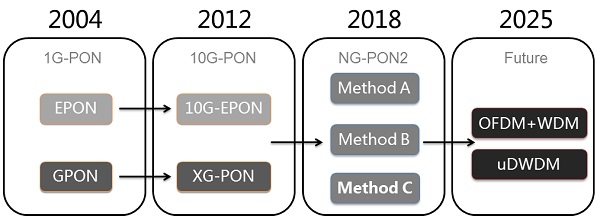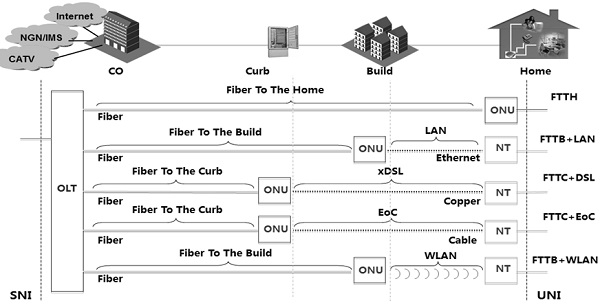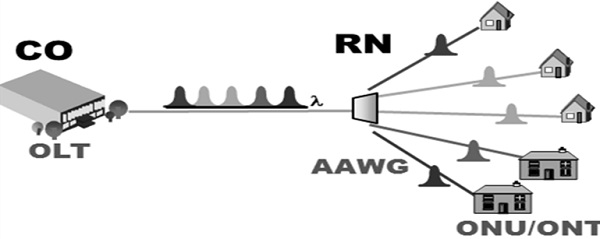
FTTH - XPON Evaluation
The following illustration depicts XPON Evaluation.

The following table explains different methods of XPON Evaluation.
| Multiplex Mode | Typical Technology | ||
|---|---|---|---|
| Method A | TDM | 40G TDM PON | OFDM PON |
| Method B | WDM | PtP WDM | |
| Method C | TDM + WDM | 40G TWDM PON | NG-EPON |
After GPON development, FSAAN and ITU-T started working on NG-PON with the following features −
- Low cost product
- Large Capacity
- Wide Coverage
- Backward compatibility
NG-PONs are divided into two phases by FSAN based on the current application demand and technology −
NG PON1 − NGPON1 is backward compatible with legacy GPON ODNs. NG-PON1 has an asymmetric 10G system with 10G downstream/download and 2.5G upstream/upload speed. This NG-PON1 is enhanced TDM PON system from GPON.
NG PON2 − NGPON2 is long-term PON evaluation, which can support as well as can be deployed over the new ODNs.
There are many ways to develop NG-PON2 unlike NG-PON1 to improve the bandwidth rate from 10G to 40G −
Using TDM technology same as being used for NG-PON1.
WDM PON (Using coarse wavelength division multiplexing (CWDM) or dense wavelength division multiplexing (DWDM).
ODSM PON (TDMA +WDMA).
OCDMA PON (Using CDMA technology).
O-OFDMA PON (Using FDMA technology).
Coexistence NG-PON1
The main feature of NG-PON1 is to provide higher bandwidth than GPON as the same time. It should be backward compatible with the existing GPON network, which will reduce the operators cost. This NG-PON defined by the FSAN and ITU-T is known as XG-PON1.
FSAN and ITU-T has defined the following data rates for XG-PON1 −
- Downstream Data Rate − 10G
- Upstream Data Rate − 2.5G
Upstream data rate of 2.5G is twice the upstream data rate of GPON. Apart from all elements of GPON, ODN (optical distribution network) can be reused in XG-PON1 network.
By adding only 10G downstream card in the existing GPON OLT, the GPON enhanced to XG-PON1.
Network Architecture and Coexistence
As described above that XG-PON1 is an enhancement to existing GPON that can support different GPON deployments such as −
- Point-to-multipoint (P2MP) architecture of GPON
- Fiber to the home (FTTH)
- Fiber to the cell (FTTCell)
- Fiber to the building (FTTB)
- Fiber to the curb (FTTCurb)
- Fiber to the cabinet (FTTCabinet)
The following illustration shows the different GPON deployments, which can be further enhanced with XG-PON1 −

Generally, there are two types of deployments −
- Green Field Deployment
- Brown Field Deployment
Green field is used where a complete new deployment is required, whereas in the Brownfield deployment, existing infrastructure will be used. So, for the Brown Field (only of GPON network) deployments, XG-PON1 can be used. In case, when copper network needs to be replaced with the fiber network, then it will be considered under the Green Field Network, as the existing network will be replaced with the new network completely.
Physical Layer
Physical layer specifications for XG-PON1 were frizzed on Oct. 2009 and published on March 2010 by ITU-T. Downstream wavelength of 1575-1580 nm is selected by FSAN. C band. L band, and O band were compared in the selection of upstream wavelength, but C band was eliminated due to overlapping with RF video channels. Since, sufficient band guard was not available on L band and due to this, the same was also eliminated and all comparison with respect to pros and cons O- band was chosen because O+ has higher requirement on filters.
| Item | Specifications |
|---|---|
| Optical Fiber | ITU-T G.652 |
| Upstream Wavelength Plan | 1260 to 1280 nm |
| Downstream Wavelength Plan | 1575 to 1580 nm |
| Power Budget |
XG-PON1: 14 to 29dB XG-PON2: 16 to 31 dB |
| Data Rate |
Upstream: 2.48832 Gbps Downstream: 9.95328 Gbps |
| Maximum physical reach | 20 Km |
| Maximum logical reach | 60 Km |
As per the above table, the downstream rate of XG-PON1 is 10 Gbps with the data rate of 9.5328 Gbps to keep the consistency with typical ITU-T rates, which is different from IEEE 10GE-PON, which is 10.3125 Gbps.
HTC Layer
The transmission layer (TC Layer) is known as XGTC (XG-PON1) transmission convergence layer, which optimizes the basic processing mechanism. The transmission convergence layer enhances the framing structure, activation mechanism, and DBA.
The enhancement in XG-PON1 framing structure is by aligning the frame and field design with word boundaries by matching the rate of XG-PON1. The DBA mechanism is more flexible with the upgradation, whereas the activation mechanism follows the same principle of GPON.
The two important features of XGTC layers are −
- Power Saving
- Security
Data encryption was an optional feature in GPON, whereas in xG-PON1 there are three methods for authentication −
First one is based on registration ID (Logical ID)
Second one is based on OMCI channels (inherited from GPON)
The third one is based on IEEE 802.1x protocols, which is a new bidirectional authentication scheme.
Upstream encryption and downstream-multicast encryption are also provided over XGTC layer.
Management and Configuration
For management and configuration ITU-T (G.984.4) recommendation was adopted in XG-PON1, which is also backward compatible with the GPON. As GPON uses the OMCI technology for management and configuration, similarly XG-PON1 uses more or less 90% of it with minor changes in ITU-T (G.984.4).
In both the cases (for GPON and XG-PON1) where lower layer technology is adopted is not a big concern as far as service is concerned. The important factor is to configure Layer 2 channel for proper forwarding of service data. All L2 configuration from the network side to user side is covered under OMCI L2 model.
The OMCI L2 model is used for both the technologies, i.e., GPON and XG-PON1 as the definition for network side and user side is same for both the technologies.
Interoperability
The most impressive part of GPON and XG-PON1 is interoperability. XG-PON1 is backward compatible with GPON, in other words, an ONT/ONU connected with GPON OLT can work with XG-PON1 OLT as well. A group was established in 2008 by FSAN, which is known as OISG (OMSI Implementation Study Group).
This group was restricted to study the (G.984.4) recommendations for OMCI interoperability for ONT management and control channel (OMCC), QoS management, multicast configuration, S/W version updates, and L2 configuration. The official number of [G.984.4] is [ITU-T G.impl984.4] and is called as the OMCI implementation guide as well.
WDM-PON
The following illustration is for WDM-PON, which also shows an array of wave-guide gratings (AWGs). These are used for the MUX and DEMUX wavelength.

P2MP WDM-PON
In WDM-PON, different wavelength is required for different ONT. Each ONT gets an exclusive wavelength and enjoys the bandwidth resources of the wavelength. In other words, WDM-PON works on a logical Point-to-Multi Point (P2MP) topology.
In the WDM-PON, AWG is needed to be between OLT and ONT. Each port of the AWG is wavelength dependent and the optical transceiver on each ONT transmits optical signals in a specified wavelength determined by the port on the AWG.
In WDM technology, the transceivers with specified wavelengths are called colored optical transceivers and the transceiver, which is can be used for any wavelength is known as colorless transceiver. There is a complexity of using colored optical transceivers, which processing service is provisioning and devising storage.
AWG components are temperature sensitive due to this, there are certain challenges for WDMPON as to address the real-time consistency between the wavelength of optical transceivers and the connecting AWG port and between the wavelengths of the port on the local AWG (at the CO) and the port on the remote AWG.
ODSM-PON
In ODSM-PON, the network remains unchanged from CO to user premises except one change, which is active WDM splitter. A WDM splitter will be placed between OLT and ONT replacing passive splitter. In ODSM-PON, the downstream adopts WDM, means data towards ONT use different wavelength for different ONT and in upstream, ODSN-PON adopts dynamic TDMA + WDMA technologies.
XGPON Standards
The following table describes the XGPON standards.
| Release Time | Version | |
|---|---|---|
| G.987 | 2010.01 | 1.0 |
| 2010.10 | 2.0 | |
| 2012.06 | 3.0 | |
| G.987.1 | 2010.01 | 1.0 |
| G.987.1Amd1 | 2012.04 | 1.0amd1 |
| G.987.2 | 2010.01 | 1.0 |
| 2010.10 | 2.0 | |
| G.987.2Amd1 | 2012.02 | 2.0amd1 |
| G.987.3 | 2010.10 | 1.0 |
| G.987.3Amd1 | 2012.06 | 1.0amd1 |
| G.988 | 2010.10 | 1.0 |
| G.988Amd1 | 2011.04 | 1.0amd1 |
| G.988Amd2 | 2012.04 | 1.0amd2 |
GPON − ITU and FSAN standardized in 2005, compliance with the G.984 × series standards.
NGPON1 −
G.987/G.988 XGPON standards have been released in 2011.
It standardized the XGPON with 2.5 Gbps upstream/10Gbps downstream.
GPON and XGPON use different wavelength for coexisting in one network.
NGPON2 −
Do not consider being compatible with existing ODN network, a more open standard of PON technology.
Now focus to WDM PON and 40G PON.
Main Features of XG-PON1
The following table describes the main features of XG-PON1.
| Item | Requirement | Remark |
|---|---|---|
| Downstream (DS) speed | Nominal 10 Gbit/s | |
| Upstream (US) speed | Nominal 2.5 Gbit/s | XG-PON with 10 Gbit/s US speed is denoted as XGPON2. It is for future study. |
| Multiplexing Method | TDM (DS)/ TDMA (US) | |
| Loss Budget | 29 dB and 31 dB (Nominal Classes) | Extended class is for future study. |
| Split Ratio | At least 1:64 (1:256 or more in the logical layer) | |
| Fiber Distance | 20Km (60 Km or more logical distance) | |
| Coexistence | With GPON (1310/1490 nm) With RF-Video (1550 nm) |
XG-PON Optical Power Class
The following table describes the minimum and maximum loss of XG-PON optical power class.
| 'Nominal1' class (N1 class) | 'Nominal2' class (N2 class) | 'Extended1' class (E1 class) | 'Extended2' class (E2 class) | |
|---|---|---|---|---|
| Minimum loss | 14 dB | 16 dB | 18 dB | 20 dB |
| Maximum loss | 29 dB | 31dB | 33 dB | 35 dB |